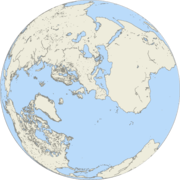Land hemisphere

The land hemisphere, sometimes capitalized as the Land Hemisphere, is the hemisphere on the Earth containing the largest possible area of land. It is centered on 47°13′N 1°32′W / 47.217°N 1.533°W (in the city of Nantes, France).[1][2] The other half of the Earth is the water hemisphere.
The land hemisphere has seven-eighths (87.5%) of the land on the Earth,[1] including Europe, Africa, North America, nearly all of Asia and most of South America. Europe is at the center of the land hemisphere. However, even in the land hemisphere, the ocean area still exceeds the land area (albeit, only slightly). While there is currently no hemisphere of Earth where the land area is larger than the ocean area, this has probably not been the case at times earlier in Earth's geological history when the Earth contained a single supercontinent (such as Pangaea). [citation needed]
References
- ^ a b Boggs, Samuel Whittemore (1945). "This Hemisphere". Journal of Geography. 44 (9): 345–355. doi:10.1080/00221344508986498.
{{cite journal}}: Unknown parameter|month=ignored (help) - ^ Judy M. Olson (1997). "Projecting the Hemisphere". Matching the Map Projection to the Need. American Congress on Surveying and Mapping. Retrieved 2007-12-14. (especially Figure 4.3)
